
The principles of Agile Change Management support organizational change in the modern workplace. Agile was first created for software development, but it is a useful way to meet the challenges of project management in a digital-first business world.
In older change management methods, leaders assume that they can simply make a plan and implement a change project from start to finish.
By contrast, Agile methods of project management take a very different approach. With agile, a team reflects on the problems facing them. Together, they decide on solutions. And when they start implementing a solution, the team will adapt, review, and change when new problems arise.
This article will explain the core principles of Agile development and change management.
It will start by explaining the basics principle of an Agile approach to project management, a set of principles that came out of software development. It will explain how Agile projects can be adapted to suit change management projects and examine the opportunities and challenges that Agile can bring to projects. Finally, it will elucidate which projects can benefit the most from an Agile approach.
What is Agile Change Management?
A group of US-based software developers first created the Agile Manifesto in 2001. Keeping with a small set of core principles allows software teams to stay agile, responsive, and solution-driven. The manifesto prioritized the following concepts:
- People First – Agile focuses on “individuals and interactions” above processes and tools. This makes agile a very customer-driven approach.
- Responding to Change – Rather than following a predefined plan, agile emphasizes flexibility and the ability to react quickly.
- Collaboration – Developers constantly contact customers and other business members, enabling flexibility and responsiveness. The core development team also regularly meets in scrum meetings to touch base and plan the day’s moves.
- Workable Software – The agile workflow also demands workability, early and often. The Agile Manifesto states that “working software is the primary measure of progress.”
Even back in 2001, software development needed new management principles. Today, Agile practitioners are finding more ways to implement these ideas. It is not just a way of creating software but represents what Gartner calls “a mental sh ift in how we approach projects.”
Fortunately, Agile’s innovative approach to management still has traditional aims of realizing business value. Melanie Franklin explains in her agenda-setting 2014 book, Agile Change Management, it “is designed to realize benefits from change as early as possible, by ensuring that the changes are prioritized according to their business value. The aim for organizations is to be agile in their approach to change – to have the ability to move quickly and easily.“
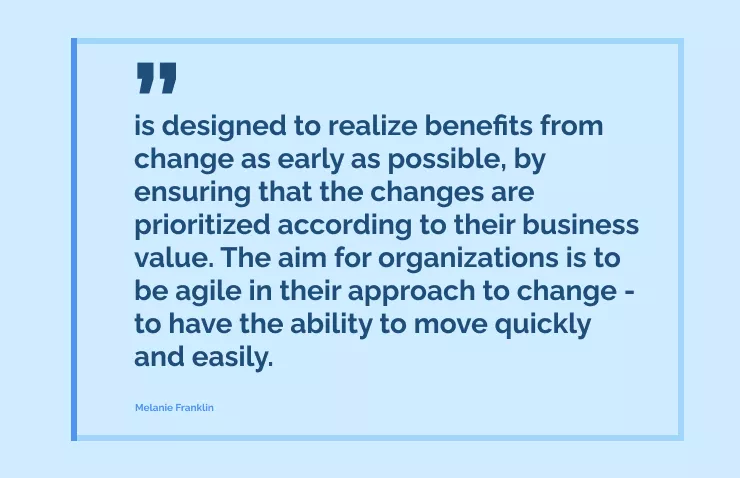
How Agile adapts to change management

To effectively apply Agile principles to project management, it is essential to adapt them to the specific project. This involves managing, processing, and handling changes to the project through Agile change management techniques.
There are several ways to apply Agile thinking to change management, whether the project is small or large. By following these steps, the project can remain lean, nimble, and agile, enabling it to respond effectively to changes. Agile processes harness change in a complex and uncertain world. An agile change management plan is an iterative process, characterized by continual review and adaptation.
Consider Unfreezing Requirements for Each Iteration
This approach allows your project to respond more quickly to changes, but it requires your developers to be more comfortable with unstable requirements.
Never model too far ahead
The further you model ahead, the less responsive your design will be to change requests. However, this need must be balanced with the availability of stakeholders.
Collaborate and adjust frequently
First, collaborate with customers because they drive your products. Then, collaborate with stakeholders and other teams as necessary.
Make sure you have a change process that is lean and fast
This is the baseline for an agile change management workflow. It isn’t agile if you have no system for changing your project.
Think “Change Efficiency” Instead of “Change Control”
In agile, change is desirable and natural. This perspective change is one of the most important in making your change management process more efficient.
Establish Rule-based Processes for Everything
There is a reason why scrum is held daily — it works. Establishing routines, habits, and systems ensures that policies get followed. Create documentation for and do the same for all of the above, including collaboration, change processes, and so on.
As we can see, agile change management is about being agile with changes to the project scope, product features, and other aspects of a project.
The Benefits of Managing Change in an Agile Environment
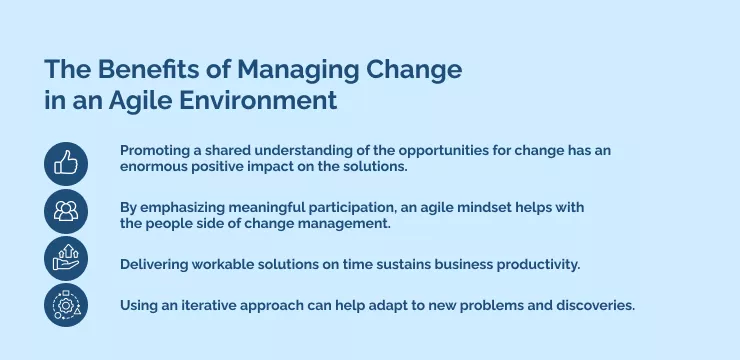
An Agile approach will improve the change solution, help employees to accept the change, and support company productivity through the implementation process. These benefits arise from specific Agile project management features for their change initiatives.
First, promoting a shared understanding of the opportunities for change has an enormous positive impact on the solutions. Agile change management encourages all stakeholders to be involved in the change process. This results in a shared understanding of the problems and opportunities that must be addressed. By doing so, organizations can ensure that the resulting deliverables are more appropriate and effective.
Secondly, by emphasizing meaningful participation, an agile mindset helps with the people side of change management. The agile methodology encourages meaningful involvement from everyone who wants to be involved in the change process. This ensures that all stakeholders have a say in the solutions being developed, which helps to ensure that the resulting solutions work for everyone. This also minimizes the time required to get buy-in from stakeholders, making the change process faster and more efficient.
Delivering workable solutions on time sustains business productivity. Agile change management focuses on providing timely solutions, even if they are not perfect. This approach helps organizations realize benefits more quickly and avoid the delays associated with achieving perfection before delivery. It also allows for the benefits of the solution to be realized sooner.
Using an iterative approach can help adapt to new problems and discoveries. An iterative approach means changes can be made midway through a project if necessary. This approach allows for improvements to be made based on an improved understanding of the problem or a better understanding of the possible solutions. This approach ensures that organizations are not left behind in rapidly evolving industries such as technology.
Overall, the benefits of agile change management make it a valuable approach for any organization looking to implement change effectively.
The challenges of Agile in Change Management
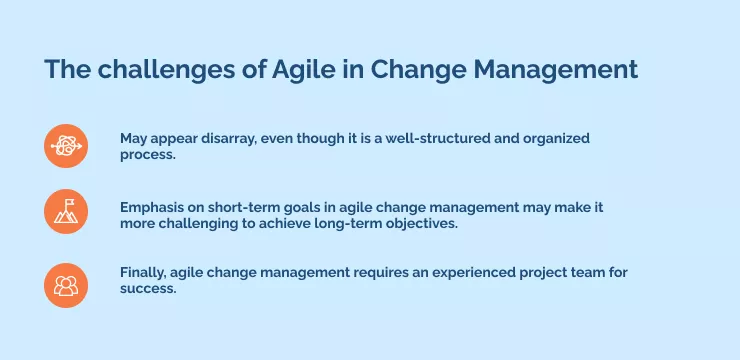
Agile change management offers many benefits, but it also presents several challenges.
One of the main challenges of agile change management is that employees accustomed to traditional project management methods may find it challenging to work with. The iterative and collaborative nature of Agile can be a significant departure from more linear and hierarchical approaches, and some team members may struggle to adjust.
Another challenge of agile change management is that it may appear disarray, even though it is a well-structured and organized process. The emphasis on constant collaboration and feedback can sometimes be misconstrued as chaos, particularly by those unfamiliar with the approach. As a result, organizations must communicate the goals and processes of agile change management to all stakeholders to ensure buy-in and support.
In addition, the emphasis on short-term goals in agile change management may make it more challenging to achieve long-term objectives. While agile can be very effective for rapidly iterating and improving upon solutions, it can sometimes be difficult to maintain a strategic perspective over the long term. This requires careful planning and coordination to ensure that short-term goals are aligned with the larger vision and mission of the organization.
Finally, agile change management requires an experienced project team for success. While agile can lead to much better solutions than traditional approaches, it requires a high level of expertise and coordination to implement effectively. This means that organizations must invest in training and development for their project teams to ensure they have the skills and knowledge necessary to navigate the challenges of agile change management.
Agile change management vs. Traditional Methods
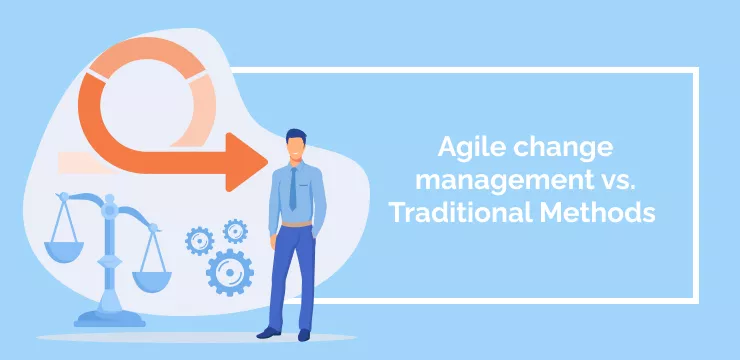
Agile is a versatile and effective project management method that can be applied to many projects. However, it may not be the best choice for all projects. To understand why comparing agile change processes to traditional change management approaches can be helpful. In this section, we will look at an alternative method – the waterfall model – to show its difference from agile.
One such approach is the waterfall model, an older method of project management that was also first developed for software development. Like Agile, it has been adapted for use in many other contexts, including change management processes. Unlike Agile, the waterfall methodology is completely linear, with six distinct stages: system requirements, analysis, design, coding, testing, and operations.
In practice, there may be overlaps between each of the six stages. However, they must always be completed in a specific order. As a result, it is tough to make changes once the project has begun. Anyone outside of the development team is isolated from the steps. As a result, it is difficult for most stakeholders to have input on the change plans.
The waterfall methodology can be very effective for projects with well-defined requirements and a clear scope. However, it cannot manage change in today’s fast-paced and constantly evolving business environment.
As a result, many organizations are turning to agile and other modern change management methodologies to help them stay competitive and adapt to changing market conditions. Agile is often much more effective for managing change in dynamic and complex environments, such as those in the digital economy.
When is Agile Change Management the Right Method?
Taking an Agile change management approach offers many benefits to businesses of all sizes. But in the end, the decision to use an Agile approach should be based on the specific needs of the project and the organization.
Some projects that are suitable for an agile approach to change management include:
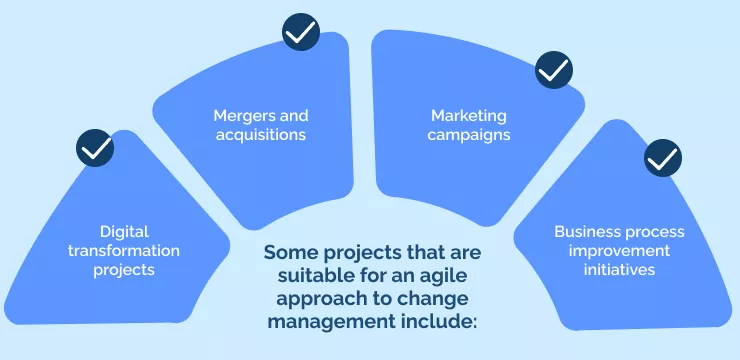
- Digital transformation projects
- Mergers and acquisitions
- Marketing campaigns
- Business process improvement initiatives
Some projects that would not suit an agile approach include:

- Changes that impact unrelated business units in large organizations
- Initiatives that with compliance concerns
- Projects with unchangeable timescales or budgets
- Large-scale infrastructure projects
Some industries cannot be as flexible as others. But in nimble, lean, and well-connected organizations, the right balance of stability, speed and change management models can ensure a project stays competitive and profitable.
Agile: Not Just For software development
Agile change management is a handy tool in this digital-first business world. In many cases, the “waterfall” approach won’t work anymore. Agile is the go-to method for flexibility and responsiveness. With Agile, change leaders focus on individual employees, changes in the situation, collaboration, and creating solutions that work.
It’s never been a better time to use Agile. After all, this is no longer a new approach. Indeed, as a 2022 Forrester article explains, “many tech execs and their teams have become quite comfortable with agile practices.” There are now training programs, consultants, and other specialists in Agile who can support companies looking for the right change management strategies.
Change projects are always risky, but Agile is a great way to enhance employee engagement and sustain business productivity.
WalkMe Team
WalkMe spearheaded the Digital Adoption Platform (DAP) for associations to use the maximum capacity of their advanced resources. Utilizing man-made consciousness, AI, and context-oriented direction, WalkMe adds a powerful UI layer to raise the computerized proficiency, everything being equal.



